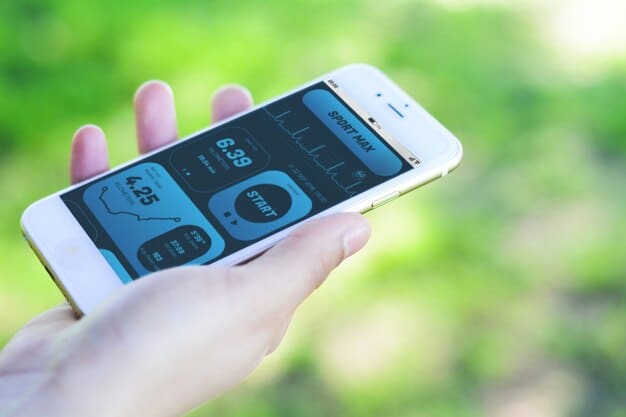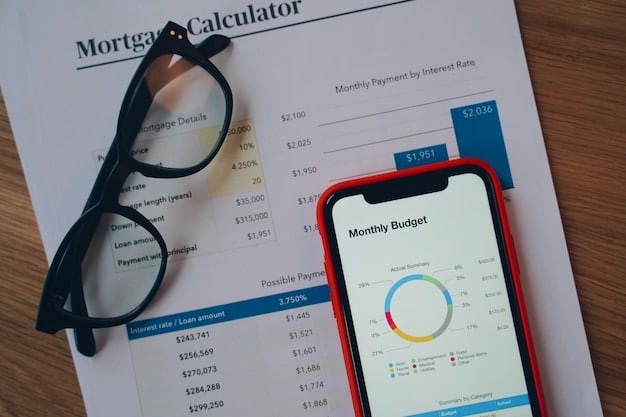Negotiating Utility Bills: Save on Electricity & Gas in 2025

Navigating utility bill negotiation in 2025 involves understanding current market dynamics, consumer rights, and effective communication strategies to secure lower rates for electricity and gas, ultimately leading to significant household savings.
As the landscape of energy consumption continues to evolve, understanding how to effectively approach negotiating utility bills: how to save money on electricity and gas in 2025 is more crucial than ever. This guide will help you navigate the complexities of energy markets, providing actionable strategies to reduce your monthly expenditures. With a proactive approach and the right information, you can significantly impact your household budget.
Understanding the 2025 Energy Landscape
The energy market in 2025 is shaped by a confluence of factors, including global supply chain dynamics, geopolitical events, and the accelerating transition towards renewable energy sources. These elements collectively influence the costs consumers face for electricity and gas. Staying informed about these broader trends isn’t just academic; it directly impacts your ability to negotiate effectively and identify potential savings.
Key Market Influences
Several underlying forces are at play. Geopolitical stability, for instance, can heavily impact the price of natural gas, a primary fuel for electricity generation in many regions. Disruptions in supply or shifts in international relations can lead to rapid price increases. Simultaneously, the growing integration of renewable sources like solar and wind power introduces new variables. While these sources often have lower operational costs, the initial investment and grid infrastructure upgrades can still influence consumer rates.
Technological advancements also play a significant role. Smart grid technologies, for example, are becoming more prevalent, offering utilities better demand management and potentially leading to more dynamic pricing models. Consumers who adopt smart home devices might be able to leverage these technologies to reduce peak energy consumption and save money.
- Global Commodity Prices: Volatility in oil and natural gas markets directly affects electricity and gas costs.
- Renewable Energy Integration: Increased solar and wind capacity can stabilize or even reduce prices in the long term, though short-term costs for infrastructure may apply.
- Regulatory Changes: Government policies and utility commission decisions can impact rate structures and consumer protections.
For individuals and families, these trends translate into fluctuating bills. Without a clear understanding of these forces, it’s easy to feel powerless. However, knowing the broader context empowers you to ask informed questions and negotiate from a position of awareness.
Anticipated Trends for Utilities in 2025
As we look ahead to 2025, several trends are likely to shape the utility sector. We anticipate a continued push towards energy efficiency programs, driven by both environmental goals and the need to manage grid demand. Utilities may offer more incentives for homeowners to upgrade to energy-efficient appliances or install smart thermostats. Another trend is the decentralization of energy, with more homes generating their own power through rooftop solar. This can reduce reliance on the grid but also introduces complexities in billing and net metering agreements.
Furthermore, expect to see an increase in personalized energy data. Utilities are investing in advanced metering infrastructure, which provides consumers with granular data on their energy use. This data, if understood and utilized correctly, can be a powerful tool for identifying waste and optimizing consumption patterns. It also allows consumers to present a strong case when negotiating rates, showing their commitment to efficient use.
Understanding these macro trends sets the stage for effective bill negotiation. It allows you to anticipate potential changes, leverage available programs, and approach your utility provider with a well-informed perspective.
Assessing Your Current Utility Usage and Bills
Before you even think about picking up the phone to negotiate, a meticulous review of your current utility usage and past bills is paramount. This foundational step provides you with the data and insights necessary to build a compelling case for negotiation. Without this detailed assessment, your efforts might be akin to navigating a maze blindfolded.
Detailed Bill Analysis
Start by gathering at least 12 months of your electricity and gas bills. Don’t just glance at the total; scrutinize every line item. Look for charges like base rates, consumption charges (per kWh or therm), delivery charges, taxes, and any surcharges. Understand how your consumption fluctuates throughout the year. Do you use more electricity in the summer due to air conditioning? Or more gas in the winter for heating? Identifying these patterns is crucial.
Consider whether there are any unexpected spikes in usage. A sudden jump could indicate a leak, an inefficient appliance, or a change in habits. Many utility companies provide online portals where you can access detailed usage graphs and historical data. This visual representation can be incredibly helpful in pinpointing irregularities or understanding your average consumption.
- Identify Peak Usage Periods: Understand when your consumption is highest and why.
- Examine Rate Structures: Determine if you’re on a fixed rate, variable rate, or time-of-use plan.
- Spot Hidden Fees: Look for any charges you don’t understand or that seem unusually high.
It’s also wise to compare your usage to previous years, if possible. Has your household size changed? Have you replaced any major appliances? Such factors can explain shifts in consumption, and having these ready helps you articulate your situation to a utility representative.
Understanding Your Consumption Habits
Beyond the numbers on the bill, reflect on your actual energy consumption habits. Are there specific appliances that are heavy energy users? Old refrigerators, inefficient water heaters, or excessive use of space heaters can significantly increase your bills. Think about daily routines: how long are showers? Is the thermostat set appropriately? Do you leave lights on when not in a room?
This self-assessment might reveal opportunities for immediate savings even before you contact the utility company. By demonstrating a conscious effort to conserve energy, you strengthen your position when negotiating. For instance, if you’ve recently upgraded to LED lighting or installed smart power strips, highlight these improvements. They show you are a conscientious consumer, not just someone looking for a handout.

Understanding your consumption habits also allows you to speak knowledgeably about your household’s energy profile. This level of detail indicates that you’ve done your homework and are serious about finding solutions, setting a professional tone for subsequent negotiations. It moves the conversation beyond a simple complaint about high bills to a data-driven discussion.
Effective Communication Strategies for Negotiation
Once you’ve thoroughly assessed your current utility usage and bills, the next critical step is to engage with your utility provider. Effective communication is the cornerstone of successful negotiation. It’s not just about what you say, but how you say it, ensuring your message is clear, well-supported, and persuasive. Remember, you’re seeking a mutually beneficial outcome.
Gathering Your Arguments and Supporting Data
Before making contact, consolidate all the information you’ve gathered. This includes your detailed bill analysis, identified usage patterns, and any steps you’ve already taken to conserve energy. Organize this data into a concise, easy-to-reference format. This could be a spreadsheet, a bulleted list, or even notes on specific bill items you want to dispute or discuss.
Consider what specific outcomes you are hoping to achieve. Are you aiming for a lower rate, a payment plan adjustment, or a waiver of certain fees? Having a clear goal will help you steer the conversation. For instance, if you’ve found a competitor offering a lower rate (where applicable in deregulated markets), have that information ready to present as leverage.
- Compile Usage Data: Keep recent bills and usage reports handy.
- Note Conservation Efforts: Document any energy-saving upgrades or habits you’ve implemented.
- Research Competitor Rates: If in a deregulated market, compare rates from other providers.
Being prepared demonstrates your seriousness and commitment. It also helps you overcome potential resistance from customer service representatives who may be accustomed to general complaints. Specific data, like “My usage for the past three months is X kWh lower than the same period last year, yet my bill has increased by Y percent due to rate adjustments,” is far more impactful than a vague statement.
Preparing for the Call: Who, What, When
Identify the correct department or contact person within the utility company. Often, a “customer service” line is a good starting point, but be prepared to ask for a supervisor or a specialized department if your initial contact cannot address your concerns. Choose a time to call when you are not rushed or stressed, allowing for a calm and focused conversation. Mid-morning or late afternoon on weekdays are often less busy than peak hours.
During the call, maintain a polite and respectful tone, even if you are frustrated. Begin by clearly stating your purpose: you are calling to understand your bill and explore options for reducing your energy costs. Present your findings calmly and logically, avoiding emotional language. Use phrases like, “I’ve been reviewing my bills, and I noticed…” or “Could you help me understand why this charge has increased?”
Be persistent but not aggressive. If the first representative cannot help, politely ask to speak with a supervisor. Document everything: the date and time of the call, the name of the representative you spoke with, and a summary of the conversation and any agreements made. This record is invaluable if follow-up is required. Remember, a utility company wants to retain its customers, and a well-informed, polite customer is often easier to help than a demanding one.
Leveraging Competition and Deregulation
In certain regions, understanding how to leverage market competition and deregulation is a game-changer for negotiating utility bills. This knowledge empowers consumers to actively choose their energy supplier, thereby potentially securing more favorable rates than those offered by their default utility provider. It’s a proactive step that moves beyond simple negotiation towards strategic consumer choice.
Understanding Deregulated Markets
In a deregulated energy market, the generation and supply of electricity (and sometimes natural gas) are separated from the transmission and distribution. This means while the wires and pipes that bring energy to your home are still controlled by a local utility company, you have the freedom to choose who supplies the actual energy. This competition among suppliers often leads to more diverse pricing plans, including fixed rates, variable rates, and even green energy options.
Not all states or regions have deregulated energy markets, so the first step is to ascertain if yours does. Websites of your state’s public utility commission or energy information administration often provide this information. If you are in a regulated market, your options for external suppliers are limited, and your negotiation efforts will focus solely on your single utility provider.
- Identify Market Type: Confirm if your state/region has a deregulated energy market.
- Research Licensed Suppliers: Look for alternative suppliers authorized to operate in your area.
- Compare Offers: Scrutinize rates, contract terms, and environmental impacts of different plans.
For those in deregulated areas, the key is to shop around. Websites exist that allow consumers to compare rates from multiple suppliers side-by-side. Pay close attention to not just the advertised rate per kWh or therm, but also any hidden fees, contract lengths, early termination clauses, and introductory rates that might jump significantly after a few months. A seemingly low rate might come with restrictive terms that cancel out any savings.
Using Alternative Offers as Leverage
Once you’ve identified competitive offers from alternative suppliers, you gain significant leverage when negotiating with your current utility provider. Even if you don’t plan to switch, presenting these alternative rates can prompt your incumbent utility to offer you a better deal. Many utilities have “retention” departments specifically tasked with keeping customers who are considering moving to a competitor.
When you call your current utility, state clearly that you are evaluating your options and have found more competitive rates elsewhere. Be specific about the rates and terms you’ve found. For example, “I’ve received an offer from [Competitor Name] for a fixed rate of [X cents] per kWh for 12 months. I’ve been a loyal customer for [Y years], and I’d like to see if you can match or beat that offer to keep my business.”

This approach transforms the conversation from a general complaint into a specific business proposition. The utility has a vested interest in retaining you as a customer, as acquiring new customers is often more expensive than retaining existing ones. Be prepared for them to ask for proof of competitive offers; having them easily accessible will make the process smoother. Even in regulated markets, expressing that you are exploring “all available options” might prompt your utility to offer available discounts or programs you weren’t aware of.
Exploring Assistance Programs and Energy Efficiency Rebates
Beyond direct negotiation, a wealth of resources exists that can significantly alleviate the burden of utility costs. These often-underutilized avenues include various assistance programs designed for low-income households, seniors, or individuals facing temporary financial hardship, as well as a plethora of energy efficiency rebates that can reduce both your initial investment in upgrades and your long-term energy consumption.
Government and Utility Assistance Programs
Several programs are specifically designed to help consumers manage their utility bills. The Low Income Home Energy Assistance Program (LIHEAP) is a federal program that provides financial assistance to eligible low-income households for heating and cooling costs. Eligibility requirements vary by state, so checking your local energy assistance office or public utility commission website is essential.
Many state governments also run their own energy assistance programs, sometimes in conjunction with LIHEAP, that offer additional support. Furthermore, many utility companies themselves have benevolent funds or hardship programs, often funded by customer donations, to help those struggling to pay their bills. These programs might offer one-time credits, deferred payment plans, or even energy audits to identify savings opportunities.
- LIHEAP: National program for heating/cooling assistance; check state-specific eligibility.
- State Programs: Look for additional state-funded energy assistance initiatives.
- Utility Hardship Funds: Inquire directly with your utility about customer assistance programs.
Don’t hesitate to reach out to social service agencies or community organizations in your area. They often have comprehensive lists of available resources and can even help with the application process. Remember, these programs are put in place to help; accessing them is a right for those who qualify, not a handout.
Maximizing Energy Efficiency Rebates
Investing in energy-efficient upgrades can yield substantial long-term savings, and various rebates can significantly reduce the upfront cost. Federal, state, and local governments, as well as utility companies, frequently offer rebates for things like upgrading to energy-efficient appliances (e.g., ENERGY STAR certified refrigerators, washing machines), installing smart thermostats, improving insulation, or switching to LED lighting.
To maximize these rebates, start by checking the ENERGY STAR website for federal tax credits and rebates. Then, visit your specific utility company’s website; they often have dedicated sections listing current rebate programs available to their customers. State energy offices or environmental protection agencies are also excellent resources. Sometimes, specific programs target certain types of upgrades or offer higher rebates in designated areas.
Consider combining multiple rebates where possible. For instance, you might get a federal tax credit for a new HVAC system, a state rebate for improved insulation, and a utility rebate for installing a smart thermostat. Carefully review the application processes for each rebate, as some require pre-approval or specific documentation. These upgrades not only lower your monthly consumption but also improve the comfort and value of your home, making them a wise investment even without negotiation.
Future-Proofing Your Utility Savings: Long-Term Strategies
While immediate negotiation can provide quick relief, truly sustainable savings come from implementing long-term strategies that address energy consumption at its core. Future-proofing your utility bills in 2025 and beyond involves a holistic approach, from smart home technology integration to continuous behavioral adjustments and an eye on evolving energy policies.
Adopting Smart Home Technology and Energy Monitoring
Smart home devices are no longer just gadgets; they are powerful tools for energy management. Smart thermostats, for instance, learn your habits and can automatically adjust temperatures to optimize energy use, often leading to significant savings on heating and cooling. Smart lighting systems allow you to control lights remotely and schedule them to turn off when not needed, reducing electricity waste.
Beyond individual devices, consider a comprehensive energy monitoring system. Many utilities offer smart meters that provide real-time data on your electricity and gas consumption. Understanding when and how you use energy can reveal patterns of waste you weren’t even aware of. This data empowers you to make informed decisions about appliance usage, peak demand times, and overall consumption habits.
- Smart Thermostats: Automate climate control for optimal efficiency.
- Smart Plugs: Control “vampire drain” from electronics not in use.
- Energy Monitoring Apps: Analyze real-time usage data from your utility’s smart meter.
The beauty of these technologies lies in their ability to provide actionable insights. By knowing precisely where your energy is going, you can target specific areas for reduction. This continuous feedback loop can refine your energy-saving behaviors and ensure that your efforts align with actual consumption patterns, leading to more substantial and consistent savings over time.
Sustaining Energy-Saving Habits and Regular Reviews
Technology alone isn’t a silver bullet; consistent behavioral changes are equally, if not more, important. Making energy efficiency a part of your daily routine—such as unplugging chargers, turning off lights in empty rooms, washing clothes in cold water, or optimizing appliance use—can cumulatively lead to significant reductions in your bills. These habits are free and evergreen, offering continuous savings without additional investment.
Regularly review your utility bills and consumption patterns, perhaps every six months or annually. What might have been an efficient practice a few years ago might be outdated as technologies and rates evolve. This regular check-up helps you stay on top of your energy profile and identify new opportunities for savings. Are there new energy-efficient appliances on the market? Has your family’s energy consumption changed with new habits or additions?
Stay informed about changes in energy policies, utility programs, and new technologies. Subscribing to your utility’s newsletter or following industry news can keep you updated on new rebate programs, tariffs, or energy-saving initiatives. By combining smart technology with diligent habits and continuous monitoring, you create a robust strategy for long-term utility bill savings, ensuring you’re not just saving money now, but also in the years to come.
| Key Point | Brief Description |
|---|---|
| 📊 Bill Analysis | Thoroughly review past bills and usage patterns before negotiating. |
| 🗣️ Effective Communication | Be prepared, polite, and persistent when speaking with utility representatives. |
| 💡 Deregulation Leverage | In deregulated markets, use competitor offers to negotiate better rates. |
| 🔋 Long-Term Habits | Combine smart tech and consistent energy-saving behaviors for lasting cuts. |
Frequently Asked Questions About Negotiating Utility Bills
▼
Yes, in many cases, you can. While not every utility company offers direct rate negotiation, many are willing to discuss payment plans, introduce you to assistance programs, or inform you about energy-saving incentives. In deregulated markets, you have even more power to negotiate by comparing offers from different suppliers and leveraging those against your current provider.
▼
Gather your recent bills (preferably 6-12 months), detailed usage history, and any information about energy-saving efforts you’ve already implemented. If you’re in a deregulated market, have competitive offers from other suppliers on hand. Knowing your average consumption and peak usage periods will also strengthen your case.
▼
If you’re on a fixed-rate plan, direct rate negotiation might be limited until your contract expires. However, you can still inquire about early contract termination fees if a significantly better offer arises, or discuss payment arrangements if you’re facing hardship. Your utility might also offer special programs or rebates that aren’t tied to your rate plan.
▼
Yes, absolutely. The Low Income Home Energy Assistance Program (LIHEAP) is a federal program that provides aid. Many states also offer their own energy assistance programs, and specific utility companies often have hardship funds or payment assistance programs. Check your state’s public utility commission and your local utility’s website for comprehensive information.
▼
It’s advisable to review your utility bills monthly to catch any discrepancies or sudden increases. For a more comprehensive review of your energy consumption patterns, doing so quarterly or at least annually is recommended. This helps you identify trends, assess the effectiveness of energy-saving efforts, and prepare for potential negotiations or plan for future upgrades.
Conclusion
Successfully navigating the terrain of utility bill negotiation in 2025 demands a blend of careful preparation, informed communication, and a proactive long-term strategy. By delving deeply into your consumption patterns, understanding the dynamic energy market, and leveraging available resources such as assistance programs and energy efficiency rebates, you empower yourself to significantly impact your household budget. It’s about more than just asking for a discount; it’s about becoming an active and informed participant in managing your energy costs, ensuring sustainable savings for the future.





